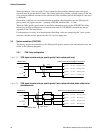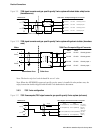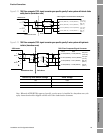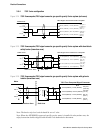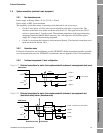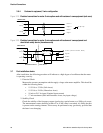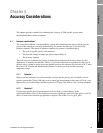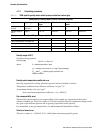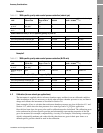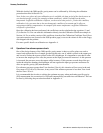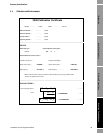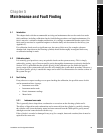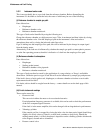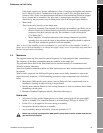
30 Micro Motion 3098 Gas Specific Gravity Meter
Accuracy Considerations
4.1.3 Calculating parameters
Density range at 20°C
Calculated using equation:
Density meter temperature coefficient error
Inversely proportional to density (therefore pressure) and is calculated as follows:
Temperature coefficient from calibration certificate = x kgm
-3
/°C
At maximum density value of y kgm
-3
:
Sensor equivalent temperature coefficient = x/y x 100%/°C
Gas compressibility error
This describes the deviation in gas compressibility of the sample gas compared with that of the
reference chamber gas. The error is taken as 2/3 of the deviation caused by temperature change on the
two gases at the reference pressure and is typically proportional to this pressure.
For information on the gas characteristics, see the International Standard Gas Tables.
Velocity of sound error
This error is taken as: – 0.0034 G %/°C, with G taken at maximum specific gravity.
Table 4-1 3098 specific gravity meter control pressure selection (natural gas)
3098 Specific Gravity Meter Control Pressure Selection
Date: Type of gas: Specific gravity
range:
3098 serial no.: Temperature coefficient of density
meter:
Control pressure
at 20°C
(lb/in
2
abs.)
(bar abs.)
18
1.2
30
2
60
4
100
7
Density range at
20°C
(kg/m
3
) 0.79–1.5 1.32–3.0 2.66–3.8 4.58–6.72
Measurement errors (% of FS specific gravity/°C) due to:
Density meter temperature coefficient
Gas compressibility of sample gas
Velocity of sound in sample gas
Reference chamber/relief valve +0.007 +0.007 +0.007 +0.007
Total error
Density range
Pρ
air
G
min
to Pρ
air
G
max
where P = Absolute pressure in bars
ρ
air
= Density in dry clean air (1.2 kgm
-3
approximately)
G
min
and G
max
= Specific gravity minimum and
maximum values



